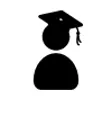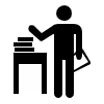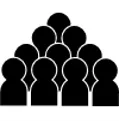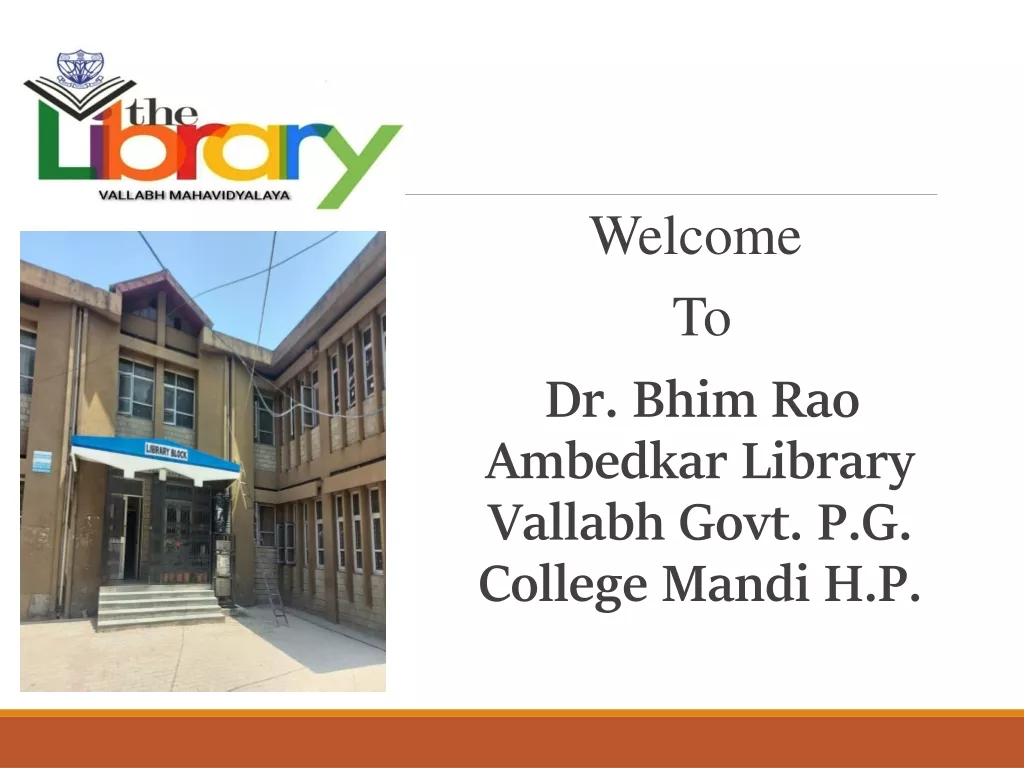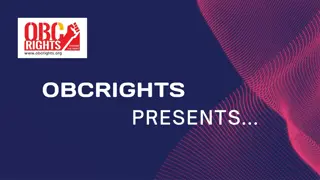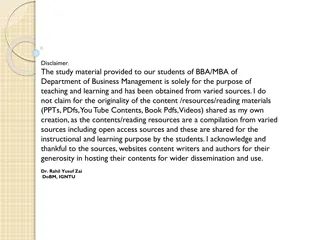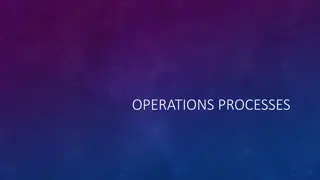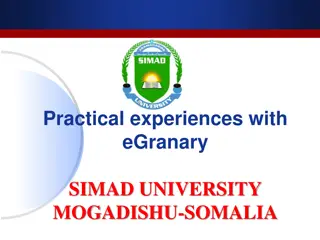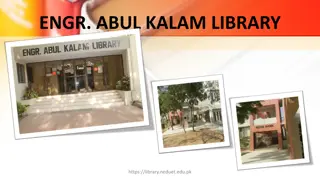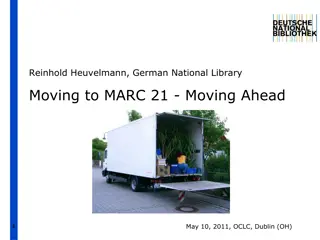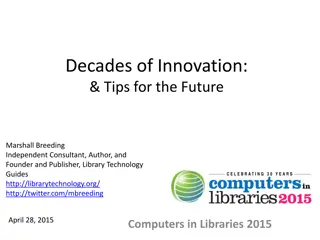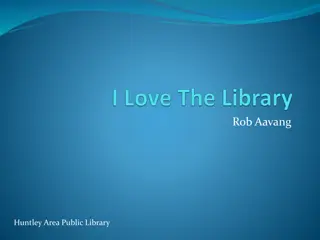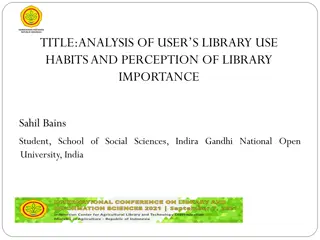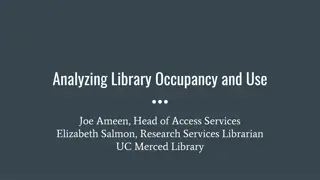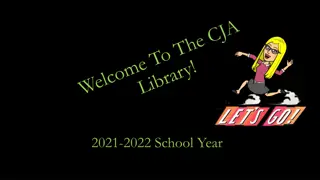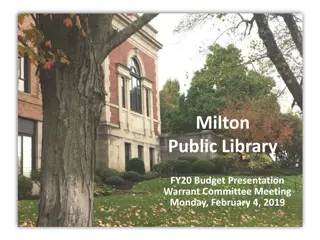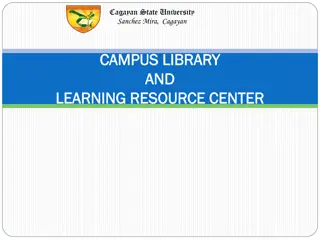Transforming Library Services: A Vision for the Future
Enhancing library services through expertise in emerging technologies, outreach, and instruction to support student success and increase enrollment. Initiatives include managing electronic resources, expanding outreach programs, and providing technology support to students. Collaboration with college recruitment and marketing aims to enrich the academic experience and improve retention rates.
Download Presentation

Please find below an Image/Link to download the presentation.
The content on the website is provided AS IS for your information and personal use only. It may not be sold, licensed, or shared on other websites without obtaining consent from the author.If you encounter any issues during the download, it is possible that the publisher has removed the file from their server.
You are allowed to download the files provided on this website for personal or commercial use, subject to the condition that they are used lawfully. All files are the property of their respective owners.
The content on the website is provided AS IS for your information and personal use only. It may not be sold, licensed, or shared on other websites without obtaining consent from the author.
E N D
Presentation Transcript
Emerging Technologies and Outreach Librarian
Emerging Technologies We need someone with expertise in managing, creating, and assessing electronic resources and services. Currently ad hoc No expertise in technology and no time to invest in professional development Technology will increasingly be an crucial component of library services Keep up with current research and library technologies that can benefit the Ca ada community Supporting open access initiatives Research affectiveness of current electronic resources and services Currently we have no one (staff or faculty) with techonlogy expertise
Outreach and Instruction More workshops, collaboration, and programs to promote new and existing services and resources both on campus and in our community. Support for student orgainizations and services, paying close attention to student diversity organizations and other programs that address equity. Increasing support for honors program and PTK Offer more LIBR 100 sections and Learning Communities with other departments
How it Helps the College Increase enrollment by partnering with college recruitment and marketing and going out into the community and visiting public libraries, high schools, and more. More use of electronic resources purchased for students, faculty, administration, and staff. Supports pathways by increasing reference, orientations, and LIBR 100 sections that support and enhance current course offerings. More support and services for faculty. More online resources, online tutorials, online guides, videos, workshops, tell us what you want!
How it Helps Students Research shows library services and instruction improve student success and retention (Wong & Cmor; Bowles-Terry; Soria, Fransen, & Nackerud; Cox and Jantti). Support student equity by providing increased access such as textbooks, laptops, and academic journals. Students need technology support; many do not have access to a laptop or desktop computer at home or access to the internet. Students view the Library as important to academic success and student satisfaction.
More FTES Faculty Librarians We only comply with this because of grants <1,000 1,001 3,000 2 In 2017 we will have 2.7 FTE Faculty Librarians 3 3,001 5,000 4 5,001 7,000 5 Each Addition 1K .5
Current Librarian Participation Technology Committee Curriculum and Technical Review Committee ACES Academic Senate ACCEL DREAMers Task Force Instructional Planning Council Various hiring committees Grants A2B STEM 4 ECE
Orientations and Reference Spring 2014 - Fall 2015 Adjuncts teach the majority of our orientations and staff the majority of hours on our reference desk. Total Reference Questions 1861 Total Orientations 230 Total Students Reached through Orientations 6069 Almost half are ESL or Basic Skills
Electronic Resource Use Spring 2014 - Fall 2015 Website 202,805 Page Views LibGuides 138,938 Hits Databases 136360 Sessions 372779 Searches YouTube Videos Views 9910 Views EBSCO Academic eBook Collection 235,999 Sessions
So What? The Library will continue to work with our current electronic resources but will not be able to assess or market them beyond the bare minimum. Students, Faculty, Staff, and Administrators will continue to be unaware of many the resources and services offered by the Ca ada Library. By Fall 2017 we will have lost almost 50% of our adjunct hours from the 2013/2014 Academic Year. Will have to cut orientation and reference hours Reduced workshops, outreach, and services Less grant work and programs
Adequate Library or Great Library?
References Wong, Shun Han Rebekah and Dianne Cmor. Measuring Association between Library Instruction and Graduation GPA. College & Research Libraries. 2011. 464-473. Bowles-Terry, Melissa. Library Instruction and Academic Success: A Mixed-Methods Assessment of a Library Instruction Program. Evidence Based Library and Information Practice. 7.1 (2012). 82-95. Soria, Krista M., Jan Fransen and Shane Nackerud. Stacks, Serials, Search Engines, and Students Success: First-Year Undergraduate Students Library Use, Academic Achievement, and Retention. The Journal of Academic Librarianship. 40. (2014) 84-91. Cox, Brian and Margie Jantti. Discovering the Impact of Library Use and Student Performance. Educause Review Online. (2012) The Academic Senate for California Community Colleges. Standards of Practice for California Community College Library Faculty and Programs. (2010) http://www.asccc.org/sites/default/files/publications/Library-paper-fall2011_0.pdf Barclays Official California Code of Regulations. Tables of Minimum Standards for Libraries and Media Centers. 5 CA ADC 58724. https://govt.westlaw.com/calregs/Document/IFC7887F0D48511DEBC02831C6D6C108E?viewType=FullText&originationContext=docum enttoc&transitionType=CategoryPageItem&contextData=(sc.Default)&bhcp=1
Images Question by Jessica Lock from The Noun Project Student by Berkay Sarg n from The Noun Project teamwork by Yazzer Perez from The Noun Project Computer by Alex Valdivia from The Noun Project Video Player by Felipe Santana from The Noun Project Library by Pieter J. Smits from The Noun Project Computer Profile by Caleb Godsey from The Noun Project Group by Parmelyn from The Noun Project Money by Lemon Liu from The Noun Project Book by Julien Deveaux from The Noun Project
Notes -ACCEL: Outreach to Pescadero, Half Moon Bay -Learning Communities -STEM 4 ECE: check in with faculty/staff involved -TLC: check in with faculty/staff involved -CWA LIBR 100 section -Connection with CTE (potential JAM collaboration) *overall information competency support in future JAMs -Potential Learning Community with Athletics










